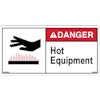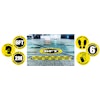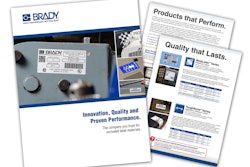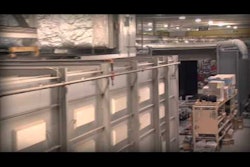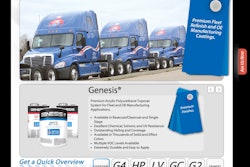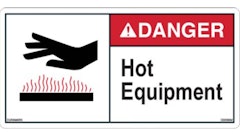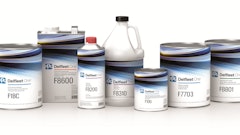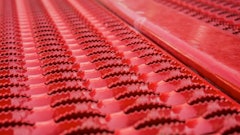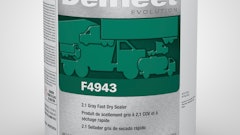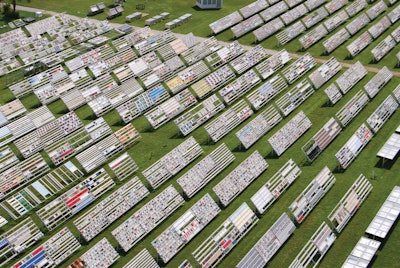
Life expectancy is a critical factor in the design and production of industrial decals, many of which are exposed to harsh outdoor conditions throughout their lifetimes. Manufacturers and suppliers alike want to ensure these graphics last as long as the products to which they're attached—but predicting the effects of real-life weather exposure on materials, inks and adhesives can be a challenge.
That's where outdoor testing and accelerated weathering processes come into play. Companies can request proof of the "weather-ability" of the materials used to create their OEM, fleet, corporate vehicle and corporate identity markings, as well as control panels and fascias, and warning labels and signage. The results provide powerful data about life expectancy in real-world environments.
Why weather-ability matters
Industrial decals, labels and other product markings, once considered an afterthought by many original equipment manufacturers (OEMs), are now viewed as important extensions to an organization's brand and corporate identity. That's why many companies demand that decal manufacturers adhere to strict guidelines—such as ensuring precise color matching of logos across various materials—and work hand-in-hand with industrial graphics suppliers on material research, development, design and performance.
Step #1: Select the right material
Industrial decals aren't "stickers;" instead, they're made from industrial-grade raw materials and substrates, printed with UV inks and enhanced with over-laminates and adhesives. The goal is to increase their lifespan, particularly outdoors.
Step #2: Leave outside for three to five years
To estimate how long these highly rated industrial materials will last outside, technical lab support is available to provide natural outdoor weathering testing. The industry standard involves mounting the materials to be tested onto a panel, positioning that panel in an outdoor field at a 45-degree angle to the sun, and then leaving the decal there for three years. Results after three years provide a "true to environment" indication of material performance and can be used to estimate lifespan.
In addition to technical lab support, some industrial graphic suppliers perform their own natural testing. To analyze various types of materials and inks, Muir Omni Graphics for example, mounts five samples of each core product in exactly the same manner outdoors. Then, once a year for five years, the quality lab pulls one of these samples for review and comparison.
But what if you don't have time to wait?
This type of real-environment testing takes time, however, and many companies don't have years to wait for results. First, you can request and review the testing done in the prior years for the materials and inks you are considering. And you can employ accelerated weather testing.
During the accelerated weather testing process, printed pieces are placed into a weather simulator and exposed to conditions that mimic sunlight, dew, rain, humidity, heat and corrosion. While the results are comparative, not absolute, they're still very telling.
How many hours in a simulator equal a year of outdoor exposure? That number is impossible to calculate due to the complexity and variability of outdoor exposure situations. While simulated weather conditions (such as wind, dew or sunlight) can be applied constantly, natural ones vary. Plus, a simulator can't account for random weather events, seasonal variations, pollution or the orientation of the printed graphic to the sun.
Color variations—both change and fade—and loss of legibility are tested using a spectrophotometer, as is the Yellowness Index (YI), a number that describes the change in color from clear or white toward yellow. YI tests are usually used to evaluate color changes in a material caused by real or simulated outdoor exposure.
Standard rating scales, typically ASTM or ISO, are used to determine the exact levels of visual color change, checking or cracking, blistering, scribe rust and corrosion, surface area coverage and instrumental gloss.
The right combination is a powerful predictor of performance
Many decal manufacturers use natural results, along with accelerated laboratory testing, to make appropriate material choices for varying product requirements. The combination approach provides predictive results, documenting visual attributes such as the degree of change in color or gloss, cracking, braising, peeling, chalking, blistering, yellowing, hazing, bleeding, shrinking, brittleness, edge curl and loss of adhesion.
All of this weather-ability testing data is vital when it comes to choosing the right material, ink, over-laminate or adhesive for your product's specific application. Just as important, it's information you can use to confirm that your industrial graphics supplier is indeed meeting your life expectancy requirements – before you learn from in-the-field failures.
If you haven't already done so, look into the lifespan of your existing decals to determine if they're achieving the performance levels you expect in the real-word, assuming you have enough years behind you. You can also ask to review your industrial graphics supplier's testing results on similar products—and inquire if any additional data exists to support product life estimates. In fact, as part of the Production Part Approval Process (PPAP), your supplier should be able to provide you with documentation proving that your product requirements are being met, and that the proper weather-ability testing exists.
With industrial graphics and decals playing an increasingly important role in your company's brand image, you want to ensure that you're using the right materials for your application and that they will meet your longevity requirements. Weather testing results can provide confidence in both your materials selections and your supplier.

